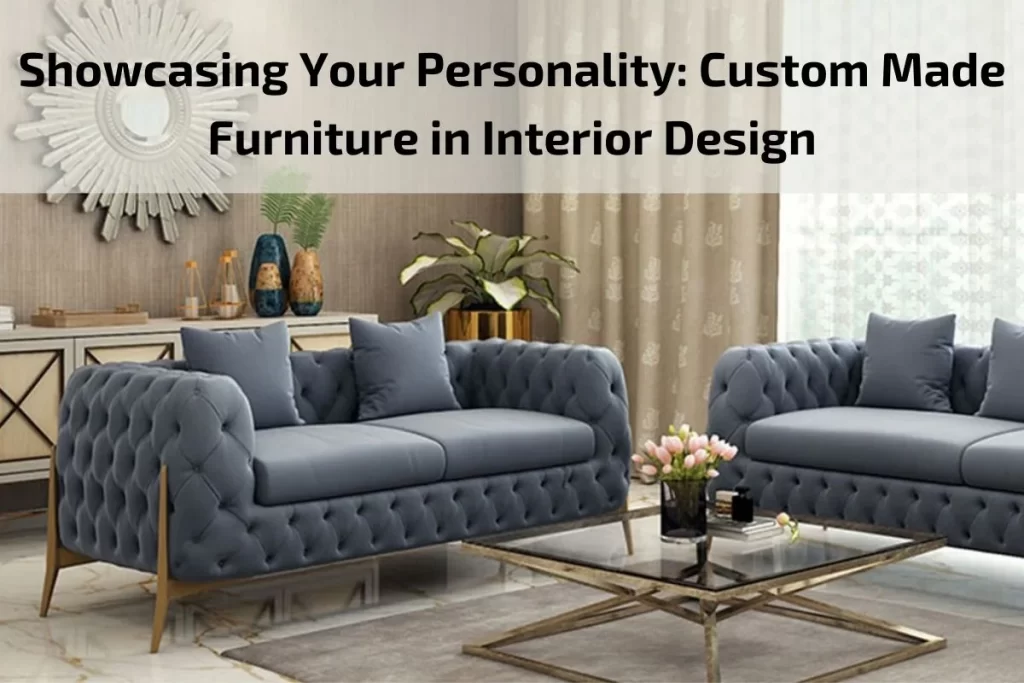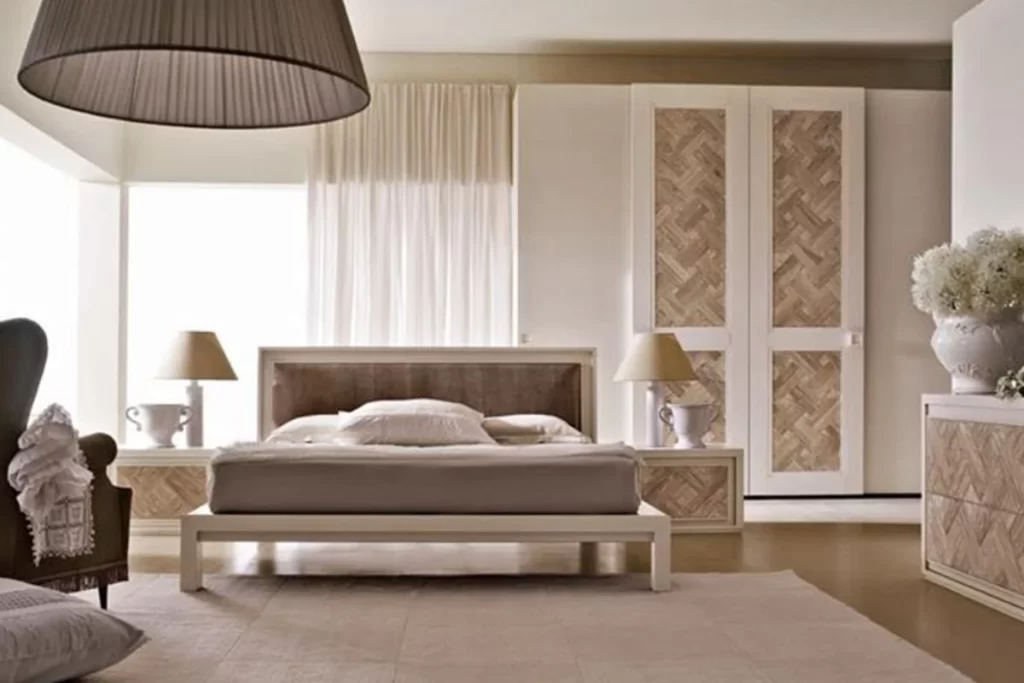
In the realm of interior design, furniture plays a pivotal role in defining the character and ambiance of a space. Each piece tells a story, reflecting the tastes, preferences, and personality of its owner. While mass-produced furniture may serve its purpose, custom-made furniture takes personalization to a whole new level, allowing individuals to express their unique style and vision in their living spaces.
Custom made furniture isn’t just about functionality; it’s a form of self-expression. It’s about infusing your personality into every aspect of your home, creating a space that resonates with your individuality and sense of aesthetics. Whether it’s a bespoke dining table, a handcrafted bookshelf, or a custom-designed sofa, each piece becomes a statement piece, adding depth and character to your interior design.
In this article, we delve into the art of showcasing personality through custom made furniture in interior design. We explore how custom furniture pieces can elevate your living spaces, reflect your personal style, and enhance the overall ambiance of your home. From design inspiration to execution, we uncover the transformative power of bespoke furniture in creating spaces that are truly one-of-a-kind.
The Rise of Custom Made Furniture in Interior Design
In recent years, there has been a notable shift in the way people approach interior design, particularly when it comes to furnishing their living spaces. Custom made furniture has emerged as a popular choice among homeowners, interior designers, and architects seeking to create personalized and distinctive environments that reflect individual tastes and lifestyles.
Custom made furniture represents a departure from the mass-produced, cookie-cutter pieces that dominate many furniture stores. Instead of settling for off-the-shelf options that may not fully meet their needs or match their style preferences, consumers are increasingly turning to custom furniture makers to bring their design visions to life.
One of the key driving forces behind the rise of custom made furniture is the desire for personalization. In a world where trends come and go, many people are seeking furniture pieces that are as unique as they are. Custom made furniture allows individuals to collaborate with skilled craftsmen and designers to create bespoke pieces that are tailored to their specific requirements, tastes, and aesthetics.
Another factor contributing to the popularity of custom made furniture is the emphasis on quality craftsmanship and materials. Unlike mass-produced furniture, which is often manufactured using inexpensive materials and assembly line techniques, custom furniture is crafted with meticulous attention to detail and using high-quality materials sourced for their durability, beauty, and sustainability.
Furthermore, custom made furniture offers unparalleled design flexibility. From the size and shape of a piece to the choice of materials, finishes, and hardware, every aspect of a custom furniture piece can be customized to suit the client’s preferences and complement the overall design scheme of their home.
In addition to its aesthetic appeal and personalization options, custom made furniture also offers practical benefits. With custom furniture, homeowners can maximize space, optimize functionality, and address specific needs or challenges within their living spaces. Whether it’s a built-in storage solution for a small apartment or a custom-designed dining table that accommodates large family gatherings, custom furniture can be tailored to fit seamlessly into any environment.
As the demand for custom made furniture continues to grow, so too does the availability of skilled craftsmen, artisans, and furniture makers who specialize in creating bespoke pieces. Thanks to advances in technology and communication, clients can now connect with custom furniture makers from around the world, expanding their options and access to unique design expertise.
Advantages and Disadvantages of Custom Made Furniture
Custom made furniture offers a plethora of benefits, but it also comes with its own set of drawbacks. Understanding both the advantages and disadvantages is essential for individuals considering investing in custom furniture for their homes. Let’s explore these aspects:
Advantages of Custom Made Furniture:
Personalization: Custom furniture allows individuals to tailor every aspect of their pieces to suit their specific needs, preferences, and style preferences. From dimensions and materials to finishes and hardware, custom furniture offers unparalleled personalization options.
Quality Craftsmanship: Custom furniture is typically crafted with meticulous attention to detail and using high-quality materials. Skilled craftsmen take pride in their workmanship, resulting in furniture pieces that are durable, functional, and built to last for generations.
Unique Design: With custom furniture, individuals have the opportunity to create one-of-a-kind pieces that reflect their personality and aesthetic sensibilities. Custom furniture allows for innovative design solutions and creative expression, making each piece a true work of art.
Optimal Functionality: Custom furniture can be designed to maximize space utilization and address specific functional requirements within a home. Whether it’s built-in storage solutions, ergonomic seating, or multifunctional pieces, custom furniture can enhance the functionality and efficiency of living spaces.
Long-Term Investment: While custom furniture may come with a higher upfront cost compared to mass-produced alternatives, it is often considered a long-term investment. High-quality craftsmanship and durable materials ensure that custom furniture pieces retain their value and beauty over time.
Disadvantages of Custom Made Furniture:
Higher Cost: Custom furniture tends to be more expensive than mass-produced alternatives due to the personalized design, quality materials, and craftsmanship involved. The cost of custom furniture can vary widely depending on the complexity of the design and the expertise of the craftsman.
Longer Lead Times: Custom furniture typically requires a longer lead time from the initial design consultation to the final delivery and installation. Individuals may need to exercise patience while waiting for their custom pieces to be crafted, especially if they have specific timelines or deadlines.
Limited Availability: Custom furniture may not be readily available for immediate purchase like mass-produced furniture found in retail stores. Finding skilled craftsmen or artisans who specialize in custom furniture may require research and exploration of local or online resources.
Design Limitations: While custom furniture offers extensive design flexibility, there may be limitations based on budget constraints, materials availability, and technical feasibility. Individuals may need to compromise on certain design elements or features to align with their budget and practical considerations.
Lack of Warranty and Return Policies: Unlike mass-produced furniture sold by retailers, custom furniture may not come with standardized warranty coverage or return policies. Individuals should clarify warranty terms and expectations with the craftsman or manufacturer before commissioning custom pieces.

Exploring Design Inspiration: Gathering Ideas and Themes for Custom Furniture
When embarking on the journey of creating custom furniture, gathering design inspiration is a crucial first step. Whether you’re furnishing a new home, renovating an existing space, or adding a unique touch to your interior design, exploring various ideas and themes can help shape the vision for your custom furniture pieces. Here are some effective ways to gather design inspiration:
Online Platforms and Social Media:
Explore design-oriented websites, blogs, and online forums dedicated to interior design, furniture, and home decor.
Follow interior designers, furniture makers, and home decor enthusiasts on social media platforms such as Instagram, Pinterest, and Houzz for curated inspiration and visual ideas.
Design Magazines and Books:
Browse through interior design magazines, coffee table books, and publications showcasing the latest trends and innovations in furniture design.
Visit your local library or bookstore to discover a wealth of design inspiration from renowned designers, architects, and artisans.
Home Tours and Showrooms:
Attend home tours, design exhibitions, and furniture trade shows to explore different styles, materials, and craftsmanship techniques firsthand.
Visit furniture showrooms, galleries, and artisan studios to view curated collections and interact with designers and makers.
Architectural Elements and Cultural Influences:
Draw inspiration from architectural landmarks, historical sites, and cultural motifs that resonate with your personal style and heritage.
Explore diverse design movements, from mid-century modern and Scandinavian minimalism to industrial chic and bohemian eclecticism, for fresh perspectives and creative ideas.
Nature and the Great Outdoors:
Take inspiration from the natural world by observing the beauty of landscapes, textures, and organic forms found in forests, mountains, and coastlines.
Incorporate natural materials such as wood, stone, and leather into your custom furniture designs to evoke a sense of warmth, authenticity, and connection to nature.
Personal Experiences and Lifestyle Preferences:
Integrating Custom Furniture into Interior Design
Custom furniture offers a unique opportunity to elevate the aesthetic appeal and functionality of interior spaces while reflecting the personal style and preferences of homeowners. When integrating custom furniture into interior design, several key considerations can ensure a cohesive and harmonious environment that showcases the beauty and versatility of bespoke pieces. Here are some strategies for seamlessly incorporating custom furniture into your interior design:
Define Your Design Vision:
Clarify your design vision and aesthetic preferences to guide the selection and placement of custom furniture within your space.
Consider the overall theme, color palette, and mood you wish to achieve, whether it’s modern and minimalist, rustic and cozy, or eclectic and vibrant.
Assess Spatial Dynamics:
Evaluate the spatial layout and dimensions of your room to determine the optimal placement and scale of custom furniture pieces.
Consider traffic flow, focal points, and functional zones within the space to ensure that custom furniture enhances circulation and usability.
Mix and Match Styles:
Strike a balance between custom furniture pieces and existing decor elements by mixing and matching styles, textures, and materials.
Blend contemporary custom pieces with vintage finds, artisanal accents, and statement accessories to create visual interest and depth.
Create Visual Harmony:
Create visual harmony and cohesion by selecting custom furniture pieces that complement the architectural features and proportions of your space.
Pay attention to scale, proportion, and symmetry when arranging furniture arrangements to achieve a balanced and inviting ambiance.
Embrace Versatility and Functionality:
Prioritize versatility and functionality when choosing custom furniture designs, opting for pieces that serve multiple purposes and adapt to changing needs.
Incorporate built-in storage solutions, convertible furniture, and modular configurations to maximize space efficiency and organization.
Focus on Comfort and Ergonomics:
Prioritize comfort and ergonomics when selecting custom seating, upholstery, and furnishings, ensuring that each piece provides optimal support and relaxation.
Consider ergonomic principles such as seat height, depth, and back support to promote proper posture and enhance user comfort.
Layer Textures and Accessories:
Layer textures, patterns, and accessories to add depth and dimension to your interior design scheme, complementing custom furniture with rugs, throws, pillows, and artwork.
Experiment with different textures such as wood, metal, fabric, and glass to create visual contrast and tactile interest.
Highlight Custom Details:
Showcase the unique craftsmanship and design details of custom furniture pieces by highlighting architectural features, lighting effects, and focal points.
Use strategic lighting, accent colors, and decorative elements to draw attention to custom furniture and create a sense of drama and sophistication.

Maintaining Custom Furniture for Longevity
Maintaining custom furniture is essential to preserve its beauty, functionality, and longevity for years to come. Proper care and maintenance practices can help protect custom furniture from wear and tear, environmental damage, and everyday use, ensuring that it retains its quality and appeal over time. Here are some tips for maintaining custom furniture and extending its lifespan:
Regular Cleaning:
Dust custom furniture regularly using a soft, dry cloth or microfiber duster to remove surface debris, dirt, and dust buildup.
Use a gentle cleaning solution and damp cloth to wipe down wood, metal, and upholstery surfaces, taking care to avoid harsh chemicals or abrasive cleaners that may damage finishes or fabrics.
Protecting Surfaces:
Use coasters, placemats, and tablecloths to protect custom furniture surfaces from spills, stains, and scratches caused by food, beverages, and everyday use.
Consider applying protective finishes, such as sealants or varnishes, to wooden furniture to enhance durability and resistance to moisture and heat.
Avoiding Direct Sunlight:
Position custom furniture away from direct sunlight, as prolonged exposure to UV rays can cause fading, discoloration, and deterioration of finishes, fabrics, and materials.
Use curtains, blinds, or window treatments to filter sunlight and minimize its impact on custom furniture surfaces and upholstery.
Proper Storage and Placement:
Store custom furniture in a climate-controlled environment with stable temperature and humidity levels to prevent warping, cracking, and swelling of wood and other materials.
Avoid placing custom furniture near heat sources, air vents, or radiators, as extreme temperature fluctuations can affect its structural integrity and appearance.
Handling with Care:
Lift and move custom furniture with caution, avoiding dragging or sliding it across floors, which can cause scratches, dents, and damage to furniture legs and finishes.
Use furniture pads or felt protectors on the bottom of chair and table legs to prevent scratching and marring of floors, especially on hardwood and tile surfaces.
Upholstery Maintenance:
Vacuum upholstery regularly using a soft brush attachment to remove dust, pet hair, and debris from cushions, pillows, and fabric surfaces.
Spot clean spills and stains promptly using a mild detergent and water, following manufacturer’s guidelines and testing a small, inconspicuous area first.
Professional Maintenance and Repairs:
Schedule periodic inspections and maintenance checks by qualified furniture professionals to assess the condition of custom furniture and address any issues or repairs as needed.
Seek professional assistance for refinishing, reupholstering, and restoring custom furniture pieces to maintain their beauty and integrity over time.
Conclusion
In conclusion, custom furniture offers a unique opportunity to create personalized and distinctive living spaces that reflect your individual style, preferences, and lifestyle. By investing in custom furniture, you can elevate the aesthetic appeal, functionality, and character of your home, transforming it into a sanctuary of comfort and beauty.

